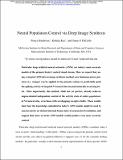| dc.contributor.author | Bashivan, Pouya | |
| dc.contributor.author | Kar, Kohitij | |
| dc.contributor.author | DiCarlo, James | |
| dc.date.accessioned | 2020-08-07T15:52:05Z | |
| dc.date.available | 2020-08-07T15:52:05Z | |
| dc.date.issued | 2019-05 | |
| dc.date.submitted | 2018-11 | |
| dc.identifier.issn | 0036-8075 | |
| dc.identifier.issn | 1095-9203 | |
| dc.identifier.uri | https://hdl.handle.net/1721.1/126511 | |
| dc.description.abstract | Particular deep artificial neural networks (ANNs) are today’s most accurate models of the primate brain’s ventral visual stream. Using an ANN-driven image synthesis method, we found that luminous power patterns (i.e., images) can be applied to primate retinae to predictably push the spiking activity of targeted V4 neural sites beyond naturally occurring levels. This method, although not yet perfect, achieves unprecedented independent control of the activity state of entire populations of V4 neural sites, even those with overlapping receptive fields. These results show how the knowledge embedded in today’s ANN models might be used to noninvasively set desired internal brain states at neuron-level resolution, and suggest that more accurate ANN models would produce even more accurate control. | en_US |
| dc.description.sponsorship | National Eye Institute (Grant R01-EY014970) | en_US |
| dc.description.sponsorship | Office of Naval Research (Grant MURI-114407) | en_US |
| dc.language.iso | en | |
| dc.publisher | American Association for the Advancement of Science (AAAS) | en_US |
| dc.relation.isversionof | http://dx.doi.org/10.1126/science.aav9436 | en_US |
| dc.rights | Article is made available in accordance with the publisher's policy and may be subject to US copyright law. Please refer to the publisher's site for terms of use. | en_US |
| dc.source | bioRxiv | en_US |
| dc.title | Neural population control via deep image synthesis | en_US |
| dc.type | Article | en_US |
| dc.identifier.citation | Bashivan, Pouya et al. "Neural population control via deep image synthesis." Science 364, 6439 (May 2019): eaav9436 © 2019 The Authors | en_US |
| dc.contributor.department | McGovern Institute for Brain Research at MIT | en_US |
| dc.contributor.department | Massachusetts Institute of Technology. Department of Brain and Cognitive Sciences | en_US |
| dc.relation.journal | Science | en_US |
| dc.eprint.version | Original manuscript | en_US |
| dc.type.uri | http://purl.org/eprint/type/JournalArticle | en_US |
| eprint.status | http://purl.org/eprint/status/NonPeerReviewed | en_US |
| dc.date.updated | 2019-09-30T17:36:48Z | |
| dspace.date.submission | 2019-09-30T17:37:01Z | |
| mit.journal.volume | 364 | en_US |
| mit.journal.issue | 6439 | en_US |
| mit.metadata.status | Complete | |
